Synergistic Research PowerCell 10 UEF, FEQ PowerCell Equalizer and Element CTS Digital AC Cords
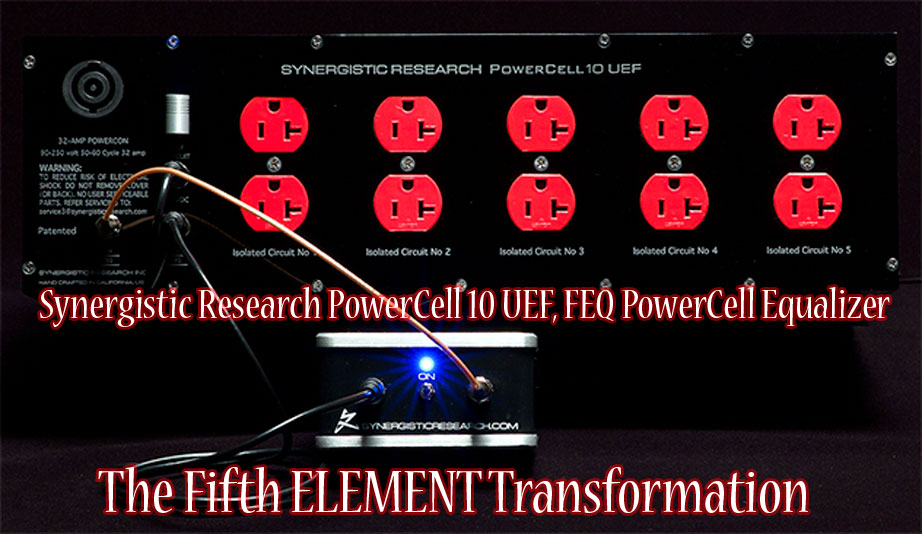
 It’s been said before and it’s worth repeating; it all starts at the AC wall socket. “The quality, structure, and efficiency of the AC entering your music system play a profound role in the musicality and dimensionality of the music your system can reproduce. The power supplies within your audio components simply do not have the ability to clear the incoming AC of all radio frequency interference (RFI), digital noise, and electro-magnetic interference (EMI), and other electrical disturbances that household AC brings when it enters your home. It’s simply not their job. This is the job of the AC line conditioner.” As you will see later, SR has found a way to build on this concept and take it to the next level.
It’s been said before and it’s worth repeating; it all starts at the AC wall socket. “The quality, structure, and efficiency of the AC entering your music system play a profound role in the musicality and dimensionality of the music your system can reproduce. The power supplies within your audio components simply do not have the ability to clear the incoming AC of all radio frequency interference (RFI), digital noise, and electro-magnetic interference (EMI), and other electrical disturbances that household AC brings when it enters your home. It’s simply not their job. This is the job of the AC line conditioner.” As you will see later, SR has found a way to build on this concept and take it to the next level.
Ted Denny, president and lead engineer at SR is constantly developing new products and revamping existing products by carrying over technology conceived for one application in the reproduction of music, applying it in a unique way, and then implementing this new breakthrough in another audio product application. In this latest iteration of the PowerCell (which btw I’ve had three total in my system), the Uniform Energy Field (UEF) technology is fully implemented within many critical locations within the PowerCell circuit. I’m no stranger to the UEF technology and the magnitude of its effectiveness. My recent reviews of the UEF HFT and FEQ room treatment, UEF tuning bullets, and XOTs SR products can be found here. In this review, I will examine the latest iteration of the PowerCell 10 AC line conditioner known as the PowerCell 10 UEF, the FEQ PowerCell Equalizer, and the previously released but updated Element CTS Digital power cable.
PowerCell 10 UEF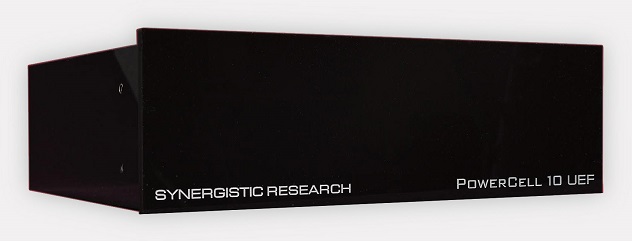
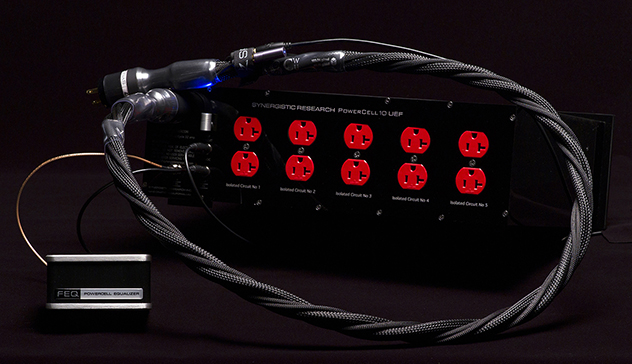
The PowerCell 10 UEF(PC UEF) consists of ten (10) SR TeslaPlex SE outlets or five (5) isolated circuits, an active Electromagnetic Cell, FEQ circuit interface, and a Neutrik 32 amp PowerCon connector, all housed in an electromagnetically and mechanically inert SAR Acrylic chassis. Included with the PC UEF is a 5 ft Element Copper Tungsten power cable which has the ability to change the voicing via UEF Tuning Bullets and a dual Mini Power Coupler that provides active shielding. The SR Element Copper Tungsten power cable by itself retails for $2000. As in the previous model, all components of the PowerCell are “Quantum Tunneled” (see the description below). The main differences between the PowerCell 10SE MKIII and PC UEF, are the redesign of the EM Cell ground plane which was conceived during the development of the SR Tranquility Base here. The addition of internal UEF circuits similar to those used in the XOT, UEF tuning bullets at critical points within the EM Cell structure and the deployment of the FEQ interface which allows connection of the FEQ PowerCell Equalizer (FEQ PE). As compared to the design of many other power conditioners in the market place which contain transformers, chokes, etc. in the conductor signal path, the EM Cell acts passively to condition alternating current with differential EM fields resulting in an AC power conditioner that is noncurrent limiting.
FEQ PoweCell Equalizer
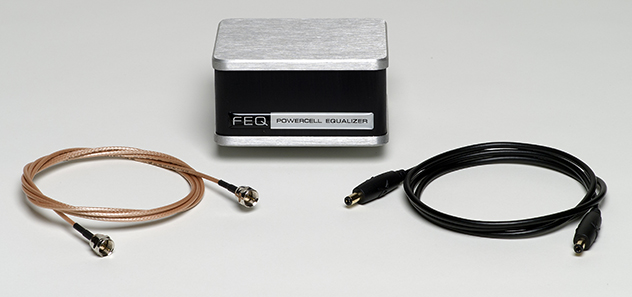
The FEQ PE is a standalone device having the dimensions of 4” x 4” x 2”. The FEQ PE includes two separate cables which are plugged into the back of the FEQ PE that interface directly with the PowerCell 10 UEF. The FEQ PE is said to re-clock the PowerCell 10 UEF from the resident AC frequency of 60 kHz to a rich low frequency harmonic as generated by the FEQ PE.
Based on my understanding of AC circuits as a materials engineer with thirty years of experience in the design and manufacture of microelectronics, I was curious as to how SR could accomplish the integration of the FEQ PE and be successful.
Element C.T.S. Digital AC Power Cable
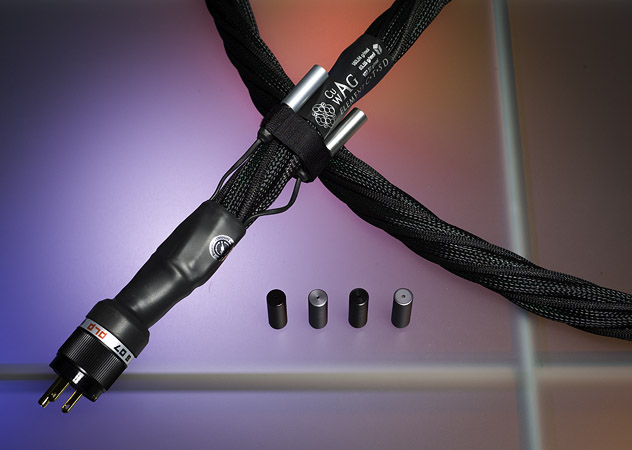
The Element Series power cables are the next progression in technology, superseding the Tesla SE series and being evolved from SR’s the top tier Galileo series cables. Attributes of the Element Series includes active shielded air dielectrics, pure Copper, Tungsten, and Silver signal conductors, UEF Tuning Circuits (as reviewed here), Quantum Tunneling, and 100% gold signal/ground conductors (wall plugs and IEC connectors). The latest version of the ElementCTS Digital power cable includes two sets of UEF Tuning bullets, one ECT and a Mini Power Coupler (MPC) that provides active shielding. The copper, tungsten and silver “air strings” conductors employed in this cable are suspended in an actively shielded air dielectric. A cross section of the Element C.T.S. Digital AC cord consists of the following parallel components:
· Handmade Actively Shielded Pure Copper Air String, x 1
· Handmade Actively Shielded Pure Tungsten Air String, x 1
· Handmade Actively Shielded Pure Silver Air String, x 1
· Actively Shielded Mid-Range Geometry, x 1
· DC Return Cables for twin circuit Active Shielding, x 2
· Silver Matrix Geometries voiced for digital components, x 4
I previously reviewed the Element Tungsten and Element Copper Tungsten AC power cables which can be found here. The plan here is to compare my previous reference, SR Tesla Hologram Digital, with its double Active Shielding and Silver Matrix Alloy (8) /Silver Matrix Weave conductors (4) to the Element CTS Digital power cable as implemented on my Laufer Teknik MP64.
The Fifth Element Revisted
My reviewing system includes the Laufer Teknik Memory Player 64 (latest software and upgrades), Pioneer bdp-09fd blu ray player, Ayon Audio Triton MKII integrated amplifier fitted with Ayon BT SX KT88 power tubes and Mazda Cifte signal tubes, Acoustic Zen Crescendo loudspeakers, REL R-528SE subwoofer, Klee Acoustics speaker cables and interconnects, Synergistic Research Tesla LE REL SPEC Subwoofer Reference cable, Synergistic Research Element power cords, Synergistic Research PowerCell 10 SE MKIII conditioner, Synergistic Research Tesla Plex SE outlets, SR HFTs and two FEQs, UEF XOTs, UEF power cable tuning circuits, and SR TQ bases. As for my listening area, its 14.5’ wide, has a 9’ ceiling, and has an open back wall to 1500 sq.ft. of first floor living area.
SR PowerCell 10 UEF
I first read about the PowerCell 10 UEF with FEQ PowerCell Equalizer (PC UEF with FEQ PE) on Synergistic Research’s Facebook page which has a YouTube link to SR’s hotel suite at T.H.E. Show Newport Beach California. Not long after reading about this new technology and checking out SR’s YouTube video, I received a call from Peter Hansen, VP of SR asking me if I would be interested in doing a review of the PC UEF with FEQ PE. Having the PowerCell 10SE MKIII in my system and enjoying what it does, I couldn’t wait to try the PC UEF with FEQ PE.
Since my Laufer Teknik MP64 was in for the three board Teflon Power Supply and Windows 8 upgrade, I first evaluated the PC UEF using my Pioneer Elite bdp-09fd Blu-ray player as the source. As a digital source component as powered by the SR Element Tungsten AC power cord, my Pioneer Elite bdp-09fd Blu-ray player is no slouch as compared to other non-computer based digital components I’ve had in my system.
 Since the Soundstage Blu-ray, Sheryl Crow Live [courtesy of A&M Records] has been getting its share of play time and I’m quite familiar with how the various tracks perform in my system, the PC UEF was first compared to the PowerCell 10SE MKIII following at least 100 hours of burn-in time. With Sheryl Crow leading her longtime band through some of her biggest hits, the audio and video is stunning on this Blu-ray recording.
Since the Soundstage Blu-ray, Sheryl Crow Live [courtesy of A&M Records] has been getting its share of play time and I’m quite familiar with how the various tracks perform in my system, the PC UEF was first compared to the PowerCell 10SE MKIII following at least 100 hours of burn-in time. With Sheryl Crow leading her longtime band through some of her biggest hits, the audio and video is stunning on this Blu-ray recording.
As with the performance upgrade from the PowerCell 10SE MKII to the PowerCell 10SE MKIII, the PC UEF excelled over the PowerCell 10SE MKIII in the following areas:
a) The noise floor dropped (which I didn’t think was possible) while exposing the finest details across the entire frequency spectrum and revealing the longest decay of individual notes.
b) The micro-dynamic shadings where further amplified to enhance the overall realism.
c) The depth and width of the soundstage expanded well past the back and side walls due to the overall reduced signal compression.
d) The presentation was more relaxed and more natural with enhanced pin point imaging.
e) The music had a more accurate tonal balance which no component has even provided.
f) The mid and lower bass lines were much easier to follow and had even greater definition.
I knew within the first 10 seconds something extraordinary occurred in my system when listening to the first track, “My Favorite Mistake.” Cheryl Crow’s voice had a greater clarity and presence while being more true to a live performance on each cut with the PC 10 UEF installed. The PC UEF stood above the PowerCell MKIII when comparing the performance of each individual instrument that comprised the band. The electric guitar played by Peter Stroud was more detailed, displayed greater micro-dynamics, and was more relaxed with the PC 10 UEF installed. On this same cut and on the 10th cut “Home”, the electric organ displayed greater depth within the soundstage and presence while having a more accurate tonal balance. The bass lines by bass guitarist, Fred Eltringham, were much easier to follow and had a better resolved pitch when my system powered by the PC 10 UEF. The PC UEF was not just a slight revision of the PowerCell MKIII but an entirely different power conditioner. I believe all due to the incorporation of the UEF technology.
SR FEQ PowerCell Equalizer
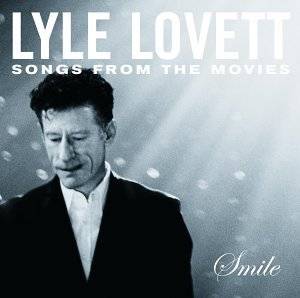 As always, after installing the FEQ PE, I allowed this component to burn-in at least 100 hours before an in depth evaluation could be started. I decided to pull out one of my go-to recordings, Smile: Songs from the Movies (MCA/Curb) by Lyle Lovett. These tunes were sung in various films from 1992-2002, mainly of the pop and jazz standards variety (“Straighten Up And Fly Right,” “Gee Baby, Ain’t I Good To You,” and the like). When I hit the play button, I could tell within three notes something extraordinary occurred in my system when listening to the 3rd cut, “Gee Baby, Ain’t I Good to You”. With the FEQ PE installed, all performance enhancements brought by the PC UEF as listed above where maintained but my system was transformed in the following areas:
As always, after installing the FEQ PE, I allowed this component to burn-in at least 100 hours before an in depth evaluation could be started. I decided to pull out one of my go-to recordings, Smile: Songs from the Movies (MCA/Curb) by Lyle Lovett. These tunes were sung in various films from 1992-2002, mainly of the pop and jazz standards variety (“Straighten Up And Fly Right,” “Gee Baby, Ain’t I Good To You,” and the like). When I hit the play button, I could tell within three notes something extraordinary occurred in my system when listening to the 3rd cut, “Gee Baby, Ain’t I Good to You”. With the FEQ PE installed, all performance enhancements brought by the PC UEF as listed above where maintained but my system was transformed in the following areas:
a) The music had much more substance (more heft) or displayed greater image density and depth filled with tonal colors and textures.
b) The presentation was even more relaxed and more natural; it had more of the warm sound I crave and hear in my tube based system.
Lyle Lovett’s voice maintained the position of just in front of the loud speaker baffle but was much bigger, more expressive, easier to pinpoint, and more articulate. The images of each instrument on the various tracks listed above had a greater density, were closer to real sizes, and were filled with diverse tonal colors when the PC UEF and FEQ PE was installed. I just didn’t think my system would ever get to this state of finality until the PC UEF with FEQ PE was installed. It was like rediscovering my hires downloads and CD library all over again.
 Another reference recording I like to use to evaluate components is from Damien Rice, [Vector Recordings/Warner Brothers Inc]. On his debut album, the Irish composer pushes boundaries in several directions of folk genre which revolve around life and love while largely producing the album himself in his home recording studio. On the third cut, “The Blower’s Daughter” from the album, where Rice recounts one of his past loves, this piece with all of its emotional expression as experienced through my system, brought me closer than ever before to the time I knew a girl named Morgan. The various guitars (acoustic, bass, and electric) played by Damien Rice and Mark Kelley seemed to have more bite and definition with each guitar string resonating in a most believable way. In comparison to the PowerCell 10SE MKIII, the lower bass notes near the end of this cut were particularly more musical, went much lower, and were better defined with the PC UEF and FEQ PE employed. The clarity of the upper midrange to lower high frequency response of the acoustic guitar and their holographic presence were greatly enhanced with the PC UEF and FEQ PE on the fourth track, “Cannonball.” In summary, each piece on this album, displayed a warmer more natural tone which reminded me of the many analog recordings I listened to in my youth. The FEQ PowerCell Equalizer wasn’t just another “box like tweak” but showed itself as an essential upgrade to the PC UEF which I believe is all due to the incorporation of the FEQ technology. The beauty of the FEQ PE lies in the fact that it provides a significant upgrade path for one who wants to start with the PC UEF line conditioner.
Another reference recording I like to use to evaluate components is from Damien Rice, [Vector Recordings/Warner Brothers Inc]. On his debut album, the Irish composer pushes boundaries in several directions of folk genre which revolve around life and love while largely producing the album himself in his home recording studio. On the third cut, “The Blower’s Daughter” from the album, where Rice recounts one of his past loves, this piece with all of its emotional expression as experienced through my system, brought me closer than ever before to the time I knew a girl named Morgan. The various guitars (acoustic, bass, and electric) played by Damien Rice and Mark Kelley seemed to have more bite and definition with each guitar string resonating in a most believable way. In comparison to the PowerCell 10SE MKIII, the lower bass notes near the end of this cut were particularly more musical, went much lower, and were better defined with the PC UEF and FEQ PE employed. The clarity of the upper midrange to lower high frequency response of the acoustic guitar and their holographic presence were greatly enhanced with the PC UEF and FEQ PE on the fourth track, “Cannonball.” In summary, each piece on this album, displayed a warmer more natural tone which reminded me of the many analog recordings I listened to in my youth. The FEQ PowerCell Equalizer wasn’t just another “box like tweak” but showed itself as an essential upgrade to the PC UEF which I believe is all due to the incorporation of the FEQ technology. The beauty of the FEQ PE lies in the fact that it provides a significant upgrade path for one who wants to start with the PC UEF line conditioner.
Element C.T.S. Digital AC power cord
Having had the Tesla Hologram Digital as my reference AC power cord on the Laufer Teknik MP64 over the last four years I’ve become quite accustomed to its sonic signature (please note the Hologram D replaced the very special Acoustic Zen Gargantua II AC power cord). After swapping in a previously burned in Element C.T.S. Digital AC power cord, is was easy to note the similarities and differences. In terms of how the two power cords are similar, the both have the same tonality but their commonality ends there. The Element C.T.S. Digital AC cord was different in the following significant ways:
a) More natural, richer, fuller sounding with the slightest bit of grain that was heard on the Tesla Hologram completely gone
b) Greater micro-dynamics
c) Greater resolution and transparency
d) Almost without a sonic signature
Getting back to one of my reference recordings, from Damien Rice, [Vector Recordings/Warner Brothers Inc], track 2, “Volcano”, I was impressed on more natural sounding my system was when I swapped in the SR Element C.T.S. Digital AC power cord.
I was also better able to clearly distinguish the vocals from bothDamien Rice and Lisa Hannigan in chorus and while both were singing together. On the fourth track, “Cannonball”, I could more clearly hear the complexity and micro-dynamic shadings with each pluck on the acoustic guitar played by Damien Rice. I also had a better appreciation of the acoustic space as each note was played.
When I cued up track 11, “Time Bomb” from the album, Dave Matthews, Big Whiskey & the GrooGrux King [RCA Records], the opening with the striking of wooden sticks displayed more of would striking wood stick together should sound like. I really enjoyed the Dave Matthews’s vocals and acoustic guitar on track 12, “My Baby Blue”. Dave’s voice and acoustic guitar playing had that sense of being in the room that us audionuts grave while expressing his true emotion about a girl he loved. This album in general would sometimes sound thin and hot on certain parts of various tracks with the Tesla Hologram Digital AC power cord installed on the LT MP64, but when I swapped in theElement C.T.S. Digital AC power cord, I was able to resist the urge to reduce the volume while listening to the high compressed parts of this recording. Again with the SR Element C.T.S. Digital AC power cord installed in my system, I desired to listen to all tracks on this album where before I would skip to certain tracks.What I really found interesting, was that I preferred the silver UEF Tuning Circuits on both legs of the active shielding with the Element C.T.S. Digital AC power cord in place. Previously, I had to mix one silver and one grey UEF Tuning Circuit when the Tesla Hologram Digital AC power cord installed due to an over saturation of high frequencies.
My Acoustic Zen Crescendo speakers seemed to disappeared better with the Element C.T.S. Digital AC power cable installed. Top to bottom, the Element C.T.S. Digital AC power cord was a better power cable indeed. The combination of the SR PowerCell 10 UEF with FEQ PowerCell Equalizer and SR Element C.T.S. Digital AC power cord on my LT MP64, moved me to listen to more of the music and less of my system. As an audio component reviewer and system tweaker; that says a lot.
Summary and Conclusions
The PowerCell 10 UEF, FEQ PowerCell Equalizer, and Element C.T.S. Digital AC power cable are engineering breakthroughs that are well made, deliver on their promised performance, and have taken my system to a level I never thought possible. They improve all areas of the sonic performance yet provide a more natural and musical presentation which is not commonly seen in audio. The combination of all three products under review has brought out the best in my associated equipment, moreover, a sound that like analog, which is at the heart of the hobby. Although the price of admission is high, the increase in system performance in relative terms justifies the cost. Thankfully, one can start with the PowerCell 10 UEF and experience the significant upgrade the UEF technology over the PowerCell 10SE MKIII and then add the FEQ PowerCell Equalizer later. The PowerCell 10 UEF, FEQ PowerCell Equalizer, and Element Series AC power cables are my new references.


Specifications:
PowerCell 10 UEF, $6000
Element Copper Tungsten AC power cable, 5ft, valued at $1800 is included
Contsruction: SAR Acrylic
Dimensions: Height 5.625″ x Width 17.75″ x Depth 14″
Weight: 19 lbs.
Connector Input: 1 each Neutrik 32 amp PowerCon, 1 each FEQ PowerCell Equalizer
US Connectors Output: 10 each Synergistic Research TeslaPlex SE
FEQ Powercell Equalizer, $995
Element C.T.S Digital AC Power Cord, 5ft, $3000
Address:
Synergistic Research, Inc.
17401 Armstrong Avenue
Suite 102
Irvine, CA 92614
Within the United States: (800) 578-6489
Outside the United States: (949) 476-0000
Website: www.synergisticresearch.com
Phone numbers:(800) 578-6489 within US and (949) 476-0000 outside the US
Stereo Times Masthead
Publisher/Founder
Clement Perry
Editor
Dave Thomas
Senior Editors
Frank Alles, Mike Girardi, John Hoffman, Russell Lichter, Terry London, Moreno Mitchell, Paul Szabady, Bill Wells, Mike Wright, Stephen Yan, and Rob Dockery
Current Contributors
David Abramson, Tim Barrall, Dave Allison, Ron Cook, Lewis Dardick, Dan Secula, Don Shaulis, Greg Simmons, Eric Teh, Greg Voth, Richard Willie, Ed Van Winkle, and Rob Dockery
Music Reviewers:
Carlos Sanchez, John Jonczyk, John Sprung and Russell Lichter
Site Management Clement Perry
Ad Designer: Martin Perry





Be the first to comment on: Synergistic Research PowerCell 10 UEF, FEQ PowerCell Equalizer and Element CTS Digital AC Cords